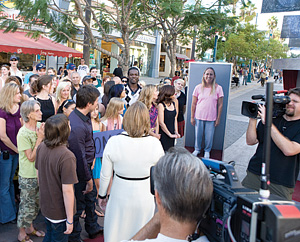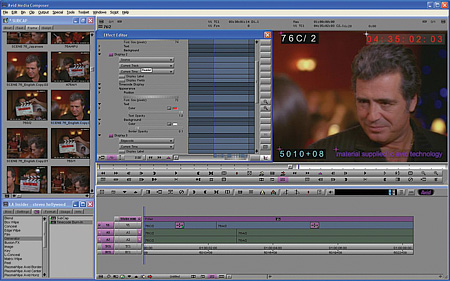Speeding Up Reality
LOS ANGELES "Ten Years Younger," a reality series on The Learning Channel puts audience participants inside a soundproof display case on some of the busiest streets in Los Angeles and New York, where complete strangers critique their looks and guess their age. Then the show's "glam squad," which includes a fashion stylist, plus makeup and hairstylists, follow a plan to take a decade off the persons' look in just 10 days.
For its upcoming fourth season, the show is not only gaining a new host, it's also going hi-def, thanks to the new affordability of production and post-production equipment. Its five-editor post production crew used new technology from Avid to deliver the requisite HD masters to the network.
"This particular editing system helps us do that more quickly," said Lead Editor Lori Szybist.
Installed last June, the system includes Avid Nitris DX hardware, Apple's Max OS Leopard operating system, and Avid Media Composer 3.0.5 software, according to consultant Darin Kerby, president, Burbank, Calif.-based Catalyst Post Services, which oversaw the system setup.
NOT MUCH TIME

TLC's "Ten Years Younger" will mark its fourth season by going HD. "With reality programming, we've got tons of footage coming in—it's not like a scripted show, where we know what we're going to get in, with maybe three or four takes of each [cut]," said Post Producer Eric Rodriguez. "We've got three weeks to cut a show—to start it, lock it, and [get it] off to online."
Kerby noted at least three ways the new technology improves production time: GPU processing, enhanced input/ output devices, and more powerful core processors.
Previously, overwhelmed CPUs were unable to deliver real-time display, forcing editors to spend time rendering their work instead of creating. Now power-enabled graphics cards and I/O hardware take on some of CPUs' work. Moreover, Kerby added, solution software optimally designates where processing takes place.
"Performance improvements derive from the integrated CPU/GPU/IO architecture, where Avid software intelligently assigns processing to the system component best suited to the specific task," said Angus Mackay, product marketing manager for Avid editing products.
Mackay also noted that the new architecture, and Avid's switch from FireWire-based hardware to a solution based on Intel's PCI Express computer expansion card interface format, also removes latency issues that used to impede response time between command and execution.
"In workflows requiring multiple HD streams, FireWire's 400 Mbps ceiling can be very limiting," he said.
A host interface board in the back of the computer connects directly with the I/O box via a PCIe cable, according to Kerby who claims that the improved architecture, plus the Quad-core or 8-core Intel processors now used by most of his customers (which were unavailable for earlier technologies), make the new solution "20 times faster than Adrenaline."
This has helped accelerate the workflow for the "Ten Years Younger" crew.
"We have several layers of video going on: in the past we had to render them to see them," said Szybist. "The ability of this system to play multiple layers without having to render is by far the biggest benefit."

The real-time multi-window timecode burn-in tool enables customers to superimpose timecode over video during output and playback. And when rendering is necessary, Szybist and Rodriguez estimate that it takes half the time it used to, or less. Moreover, said Rodriguez, "if you're in a screening and you want to change out an effect—a wipe, dissolve, whatever—it can be as simple as dragging the new effect on top of your clip and playing it right there."
Before June, the post production crew would have to output to a tape deck or other timecode generator to get a timecode window for notes and referencing, according to Rodriguez. Now the process is "drag and drop," thanks to a real-time, multi-window timecode burn-in tool, he said.
This tool is a new feature of the 3.0 versions of Avid's Media Composer and NewsCutter, and the 7.0 version of its Symphony software, said Mackay.
"It's a real time effect that allows you to add timecode display in the timeline—and if you change your timeline, it automatically updates," said Kerby. He also noted that you can output the tool. "You can put it on tape if you're doing deliveries," he said.
MOVE TO HI-DEF
"We have the ability to up-res to a full HD output," said Rodriguez. "The Adrenaline didn't have that capability, unless you upgraded with an HD card."
Despite this, the crew generally down-converts its offline edits to standard definition, to avoid added storage and bandwidth costs. They think that seeing HD content offline more often would be a plus.
Mackay said that Avid's DNxHD codec enables the creation of mastering-quality HD media using dramatically reduced file sizes, while its Unity storage solutions lower cost per terabyte. "When we introduced Unity 5 earlier this year, the price of the system had dropped approximately 50 percent from previous generations," said Mackay. He declined to comment on further savings in the near future or on any other near future features in the pipeline.
The professional video industry's #1 source for news, trends and product and tech information. Sign up below.
